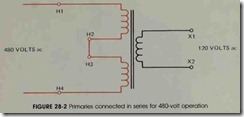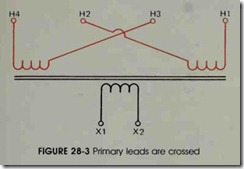Objectives
After studying this unit, the student will be able to:
• Discuss the use of control transformers in a control circuit
• Connect a control transformer for operation on a 240- or 480-volt system
Most industrial motors operate on voltages that range from 240 to 480 volts. Magnetic control systems, however, generally operate on 120 volts. A control transformer is used to step the 240 or 480 volts down to 120 volts to operate the control system. There is really nothing special about a control transformer except that most of them are made with two primary windings and one second ary winding. Each primary winding is rated at 240 volts and the secondary winding is rated at 120 volts. This means there is a turns ratio of 2:1 (2 to
1) between each primary winding and the second ary winding. For example, assume that each pri mary winding contains 200 turns of wire and the secondary winding contains 100 turns. There are two turns of wire in each primary winding for every one turn of wire in the secondary .
One of the primary windings of the control transformer is labeled H1 and H2. The other primary winding is labeled H3 and H4. The second ary winding is labeled X1 and X2. If the trans former is to be used to step 240 volts down to 120 volts, the two primary windings are connected parallel to each other as shown in figure 28-1. No tice that in figure 28-1 the H1 and H3 leads are connected together, and the H2 and H4 leads are connected together. Since the voltage applied to each primary winding is the same, the effect is the same as having only one primary winding with 200 turns of wire in it. This means that when the transformer is connected in this manner, the turns ratio is 2:1. When 240 volts are connected to the primary winding, the secondary voltage is 120 volts.
If the transformer is to be used to step 480 volts down to 120 volts, the primary windings are connected in series as shown in figure 28-2. With the windings connected in series, the primary winding now has a total of 400 turns of wire, which makes a turns ratio of 4: 1. When 480 volts is connected to the primary winding, the second ary winding has an output of 120 volts.
Control transformers generally have screw terminals connected to the primary and secondary leads. The H2 and H3 leads are crossed to make connection of the primary winding easier, figure 28-3. For example, if the transformer is to be con nected for 240-volt operation, the two primary windings must be connected parallel to each other as shown in figure 28-1. This connection can be made on the transformer by using one metal link to connect leads H 1 and H3, and another metal link to connect H2 and H4, figure 28-4.
If the transformer is to be used for 480-volt operation, the primary windings must be con nected in series as shown in figure 28-2. This con nection can be made on the control transformer by using a metal link to connect H2 and H 3 as sh own in figure 28-5. A typical control transformer is shown in figure 28-6.
REVIEW QUESTIONS
1. What is the operating voltage of most magnetic control systems?
2. How many primary windings do control transformers have?
3. How are the primary windings connected when the transformer is to be
operated on a 240-volt system?
4. How are the primary windings connected when the transformer is to be
operated on a 480-volt system?
5. Why are two of the primary leads crossed on a control transformer?





